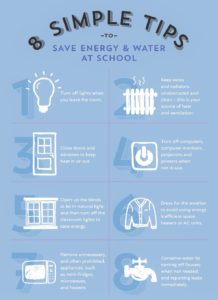Top Tips to Save Energy in Schools
Ways to saving energy in schools:

Schools use a dramatically large amount of energy and quite a lot of this is unnecessarily wasted. This means that education facilities are spending a lot of their allocated budget on energy, despite potentially not using all that they are paying for. The Government reduces the allowance for education annually, and as budgets are becoming more and more limited, saving energy through minimizing running costs and power wastage in schools, is a method that can come in very useful.
To combat this, schools that may over-use their energy resources need to first start to think about what exactly they waste their energy on. For example, ‘Lighting’ is one of the main culprits for overuse, and a prime example of how schools may unknowingly waste excess energy. When you assess the daily routine within an academy, school or college, you realise that the very first action a staff member takes, would be to turn on all of the lights in the premises or at least in the main classrooms, to initiate the start of the working day. These lights remain on throughout the entire duration of a normal school day, as well as after hours for teachers working overtime, or cleaners and caretakers in the evening. These lights would either then be switched off for the very first time that day, right at the end of the evening once all staff and students have left, or could even remain on for security purposes throughout the night!
Once schools have identified that this could be a similar issue for their own institution, or they have found what specific devices consume the most energy in their case, they can start to implements methods to save energy by using these helpful tips.
Just some of the simple things for saving energy in schools:
- Turn lights off in every empty rooms no matter the time of day
- Use energy-efficient LED lighting
- Generate your own electricity with Solar PV power
- Install timed tap systems
- Review the timers set on boilers
- Try to use a more exact amount of water needed for drinks, no excess
- Draught proof windows and doors
- Insulate the roof spaces
Tops tips:


Tip 1: Standby appliances need to be switched off via the wall socket, meaning someone has to switch it off manually. This will help reduce the wasted energy being used while the appliances aren’t even occupied
Tip 2: Keep your classroom doors closed whenever possible. This will help prevent cool or warm air from escaping. This keeps the heat in the rooms without having to continuously turn up and down the heating, which consequently uses more energy.
Tip 3: Don’t overheat or overcool. In winter, set your school’s thermostat to 18°C–20°C and in summer set it to 24°C–27°C. This way the thermostat will stop the heating systems using as much energy.
Tip 4: Remind everyone to turn off appliances at the wall when they are not in use. Appliances that are not in use are running in the background. As energy is being wasted, there is less available energy to be used elsewhere within the school.
Tip 5: Remember to turn the lights off when you leave a classroom. Schools keep lights powered on permanently as it is easier than switching them on and off.


Tip 7: Check your school’s appliances, such as computers, fridges and kitchen equipment, to see how their energy efficient they are (Eco powered). Computers in schools are commonly found to be using large amounts of energy because running costs have not been previously known.
In addition to making immediate changes, why not venture into making more permanent alterations to items that require replacement or improvement, such as inefficient lighting that can be changed into more energy efficient LED’s, or slow computer systems swapped to Ethernet powered devices that allow them to run faster and for less money. ELe powered computers and lighting systems are proud to offer a high standard of energy efficiency, and on average (based on previous installations at schools in the North West UK – Read more about our Education Projects) have saved at least 70% on electricity bills and running costs. In a school environment our systems are ideal, as they provide a safer, lower voltage, lower energy wasting solution to existing devices, which allow for more money to be saved that can be spent on teaching resources and even training teachers themselves!
Funding
Funding support for schools is available from Salix Finance who provides interest-free government funding to the public sector to improve energy efficiency and reduce carbon emissions.
If you are thinking of upgrading your school lighting system the ELe® team will manage the whole project from the initial site-survey, consultation, design, LED installation and will even write and submit the Salix Finance application on your behalf making the switch could not be simpler.
Tags In
Related Posts
6 Comments
Leave a Reply Cancel reply
Recent Posts
Latest Comments
- Alvario gordon on Electricity AC / DC – Made Simple
- SCOE on Top Tips to Save Energy in Schools
- Phoebe on Top Tips to Save Energy in Schools
- Andy Cameron on Top Tips to Save Energy in Schools
- Cindy Williams on Top Tips to Save Energy in Schools







The above top tips are best for me,as it will be helpful for those who are connected to schools.
Glad you liked them Anita, let us know how you get on if you manage to make use of any of the tips. It’s always good to hear feedback.
Great tips! We can do a lot to save energy, not in schools only but also in residentials and commercials. In my case, I used to forget turning off the geezer and AC before leaving the house. We all; not once, but many times do this type of silly mistake. After getting connecting to smart Bluetooth-powered home appliances it becomes very easy to turn off any home appliance through phone, even if you are not at home. Changing CFLs or old lighting products with LED products is also a good option.
Good to read practical tips that don’t necessary require upfront investment as its finding the funds find the funds for energy reducing projects. Our school had dripping taps and was spending thousands on paper towels, we came across a company that would allow us to pay for water saving sensor taps and hand dryers through the savings we were making so there was no budget to find and once they were paid off we made substantial savings that went back into the budget for the really important stuff
very nice
wow nice tips to save energy and they are really working and very useful tips, thanks
engineering college in navi mumbai